Richard has been kind enough to send in this fab narrative of his coal mine railroad:
“This begins a story that covers 35 years. I started designing this railroad in the early 1970s based on my love of train layouts I had as a child and began construction in the latter part of the 1970s.
My childhood involved S Gauge American Flyer trains but this project had to be more than just a circle of track on a 4 foot by 8 foot layout so I chose to build my current train in N Gauge to allow for a more realistic model in essentially a 2.5 x 8 foot space.
The plan was to have block and sector control for almost every 3 feet of track from a control panel with multiple DPDT rocker switches with a center off position. This concept predated many of the advanced control systems of today. This allowed for multiple power supplies to service up to three trains simultaneously.
The railroad concept was to be a logging and coal distribution layout from the forest and stone quarry at one end and coal mines at the other end to a distribution yard location in the middle section.
It would have passenger service provided to move workers to the forest and mine locations as well as a through route to distant cities.
The railroad is an extended helix design that travels from one end of the layout to the other while rising in elevation to service the two industries. The railroad project was photographed throughout the construction phases to highlight the elements added in each phase. A layout sketch is shown in Figure 1 and the actual control panel is shown in Figure 2.
Figure 1 control panel sketch shows turnout controls at the top and bottom and block and sector switches placed throughout the layout. Dotted lines show track in tunnels.
Figure 2 shows the actual control panel. The green, blue, orange, purple labeled tracks are stacked above each other in the upper tunnel areas to conserve lateral space.
A number of lighting features and turnout labels on the actual right of way would be added later The first construction project on the railroad was to build two wooden high mountain trestles to span an open valley as one of the central themes.
It was designed and constructed as two balsa wood structures built from scratch resembling high mountain structures of the 1930s and 1940s in the US. I built the two long bridges in Figure 3 by estimating the span based on the railroad plan and sketch I had settled on much earlier.
Figure 3 trestles located in the middle of the layout with no screen or plaster scenery.
Figure 4 shows a shelf on the left side of the layout for the logging and lumber industry. A cavity beneath the railroad contains the wiring for all tracks and features.
The upper shelf in Figure 4 shows the planned location for the stone quarry and logging and lumber cutting industrial site.
A vertical panel is planned for the back side of the entire layout and would be removable to access tracks for maintenance within the mountains in case of derailment.
The upper shelf in Figure 5 shows the planned location for the coal mining operation.
Figure 5 also shows a shelf on the right side of the layout for the coal mining operation.
Figure 6 shows the back side of the layout with the cover panel removed. Tracks are stacked as part of the extended helix configuration and the block and sector wiring is routed and taped to the vertical risers that support the tracks.
The tracks are stacked at the back side of the layout before installing the back panel.
At this stage of construction, train and turnout operation was checked before adding screening and plaster scenery so corrections to the layout could be made without undue disassembly.
Unfortunately, career obligations, vacations to most of the US National Parks and biking for rails-to-trails recreation limited the time available to continue the railroad construction for at least 30 years until I retired.
After retirement, I was eager to begin working on the model railroad again. The delay, however, caused excessive track corrosion which impacted train operation. Track cleaning was taken on as a major unplanned event and seemed to solve the continuity problem and I moved on to creating my empire.
Nylon screening was chosen to support the plaster and was screwed to free standing support posts and to the existing railroad superstructure as shown in Figure 7, 8 and 9.
Figure 7 support posts for the screen and plaster
Figure 8 coal mining region with screen mesh in place.
Figure 9 stone quarry and forest logging and lumber region with screen mesh in place.
About 40 pounds of uncolored plaster was added over several months to give the railroad a mountainous terrain as shown in figures 10, 11 and 12.
Figure 10 stone quarry and forest logging and lumber region with plaster in place.
Figure 11 coal mining region with plaster in place.
Figure 12 complete railroad with plaster in place.
Ground color, buildings and selected regions of grass, bushes and trees were added to bring the railroad closer to a final presentation.
Figure 13 shows the completed stone quarry, forest logging and lumber cutting industry. A shipping dock and crane tower were added to facilitate movement of raw and cut lumber. A small rail station and hotel service the workers at this industrial site.
The log saw mill is high on the mountain top along with a green seemingly water tower on Lambs Knoll. Lighting has been added for a night operation.
The trestle bridges were stained a more reasonable burnt orange as shown by Figure 14.
A coaling tower and coal dump station were added in Figure 15 to the yard location with an unlikely covered bridge to allow heavy trucks to move to either site. Colored posts were added to each turnout location as labels identical to that on the control panel for ease of operation. Rail cars have found their way into the yard at Trestle Junction.
Figure 15 railyard and coal processing region at trestle junction.
Figure 16 shows the coal mining region. It started out with a small coal mining operation and soon flourished into a major coal processing facility accompanied by a general store, hotel and rail station to service the mine workers.
The white tower at the far left in Figure 16 is a hardened but abandoned microwave relay antenna tower at Cross Mountain. Tropo-scatter communication antennas are shown on the right side of Figure 16 for the Hearthstone Mountain facility.
The radar dome was added for color but does not exist in the real environment just like the actual coal mining facility due to the high power transmitting site. Lighting has also been added to the night time operation of the modeled coal mining facility.
Figure 17 shows the completed cole mine railroad. Track conductivity was again becoming a problem and the cleaning process is now more difficult even with access to the tunnels.
Phase II
The Extended Helix Railroad is being modified to include another 2.5 foot by 4 foot section beyond the coal mining facility but at a lower level to enable trains to change direction without traveling to the top of the mountain and back down, a short coming in the original design.
Secondly, the deterioration of the track conductivity has led to a bold step into the future of model railroading. Research has led to the concept of battery power for train operation.
“N” gauge is quite small and limiting when trying to shoehorn in a battery power system into freight and passenger cars to electrify the engine motor when the battery cannot be integrated in a steam or diesel locomotive. A control chip and speaker must find their way into the tender of the steam locomotive or into the “B” unit of a diesel locomotive.
Both the steam locomotive tender and the “B” unit must be permanently connected together along with the battery powered freight or passenger cars. This means the train must always be configured with at least two or more battery powered cars.
Lithium Ion batteries have been made small enough to package two batteries into a passenger cars for a passenger train but must be configured in four freight cars or four flat cars for a freight train. Four batteries in series are required for a 14.8 Volt at nominally 1.5 A/hour. A controller must radiate the signal that controls the pulse width modulation used by the motor in the locomotive to efficiently control the use of battery power.
Lithium Ion Batteries have been procured for a 3.7 V and 1.8 A/hour rating. Military grade connector pins have been ordered to conveniently connect the cars together and charge the batteries when needed. The next expense is for the control system offered by Ring Engineering.
A follow report will document the expansion of the railroad and operation under battery control.
Richard”
A huge thanks to Richard – I can’t wait to see his update. Fab stuff.
That’s all for today folks.
Please do keep ’em coming.
And if today is the day you stop dreaming and start doing, the Beginner’s Guide is here.
Best
Al
PS More HO scale train layouts here if that’s your thing.
Need buildings for your layout? Have a look at the Silly Discount bundle.
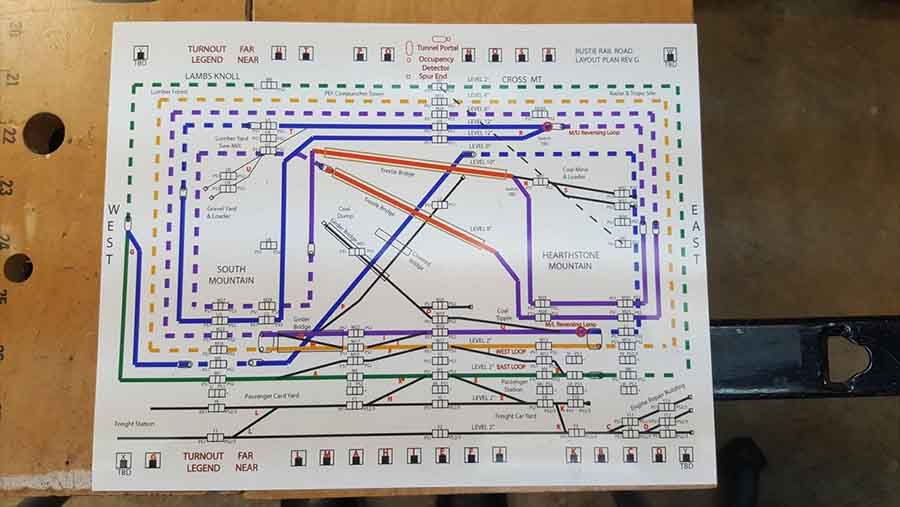
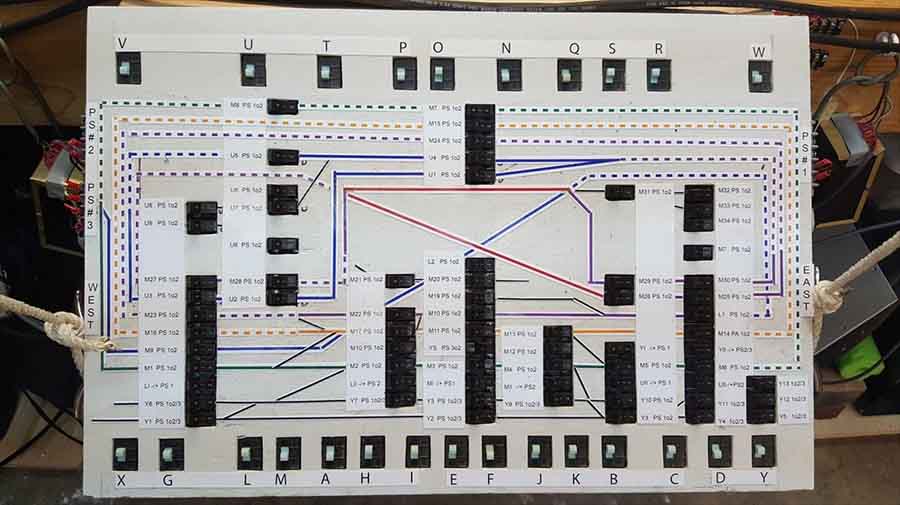
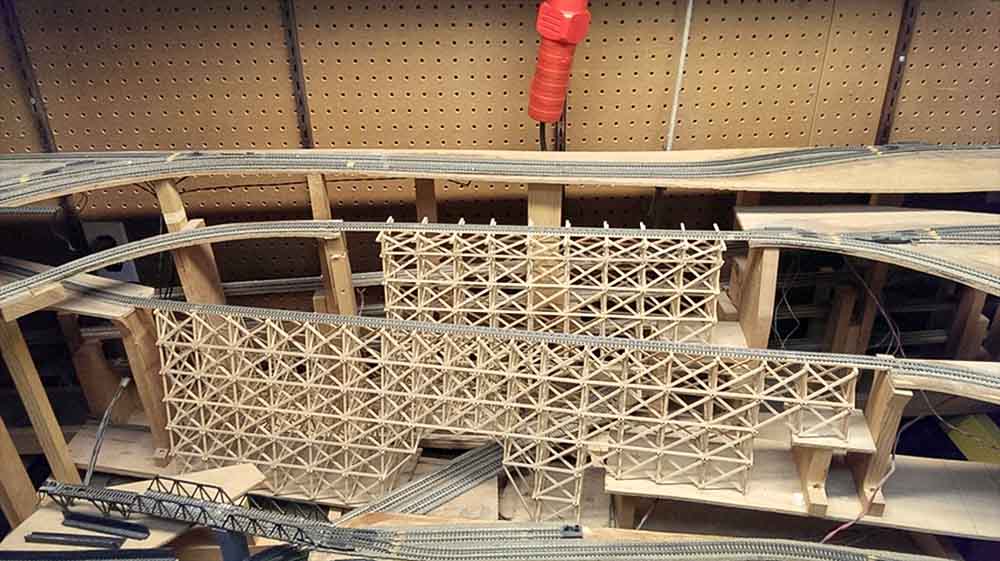
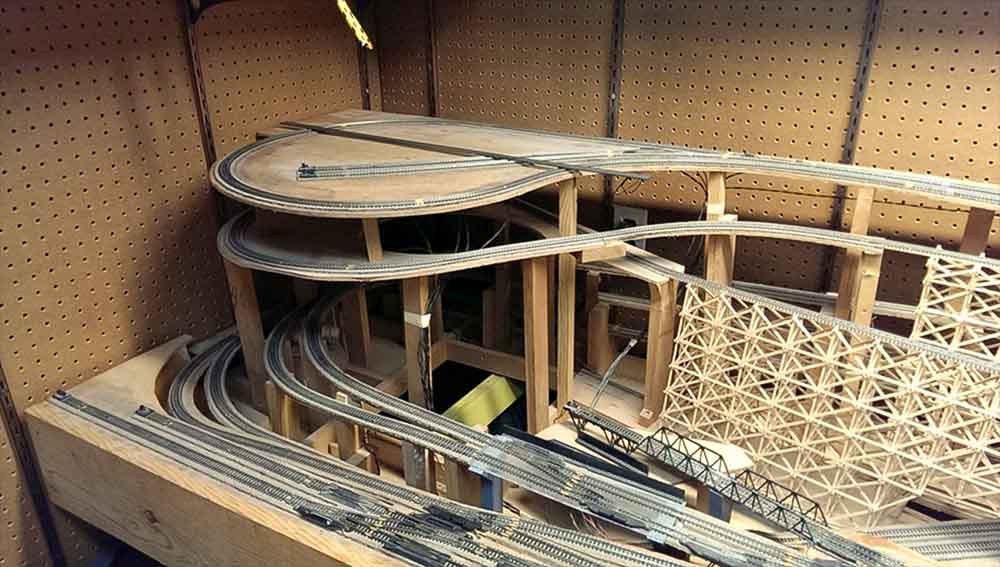
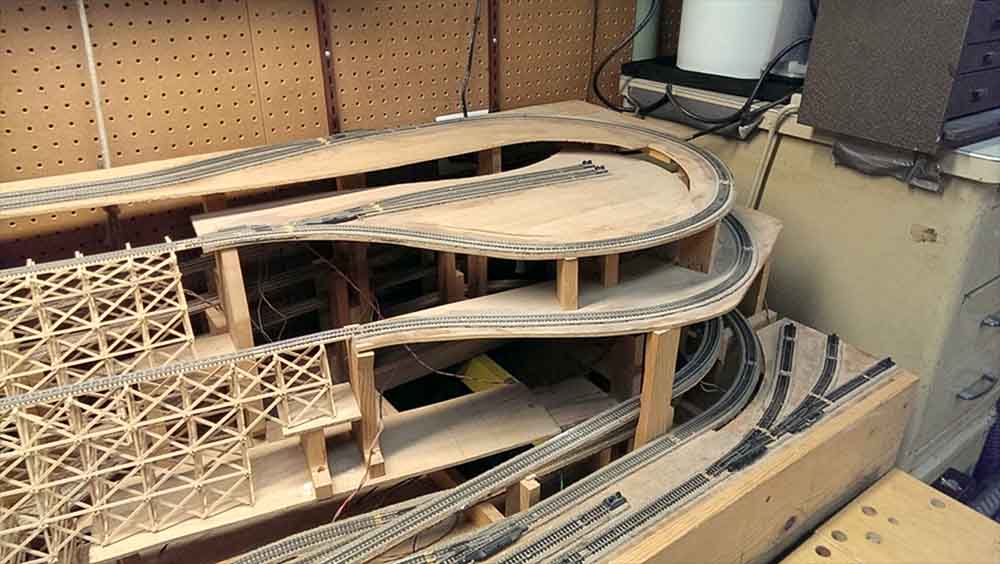
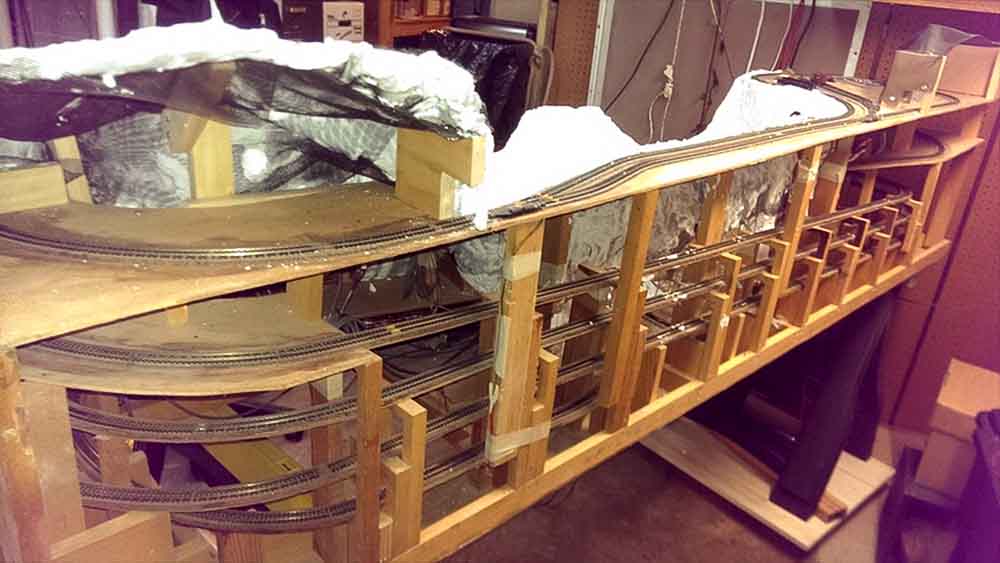
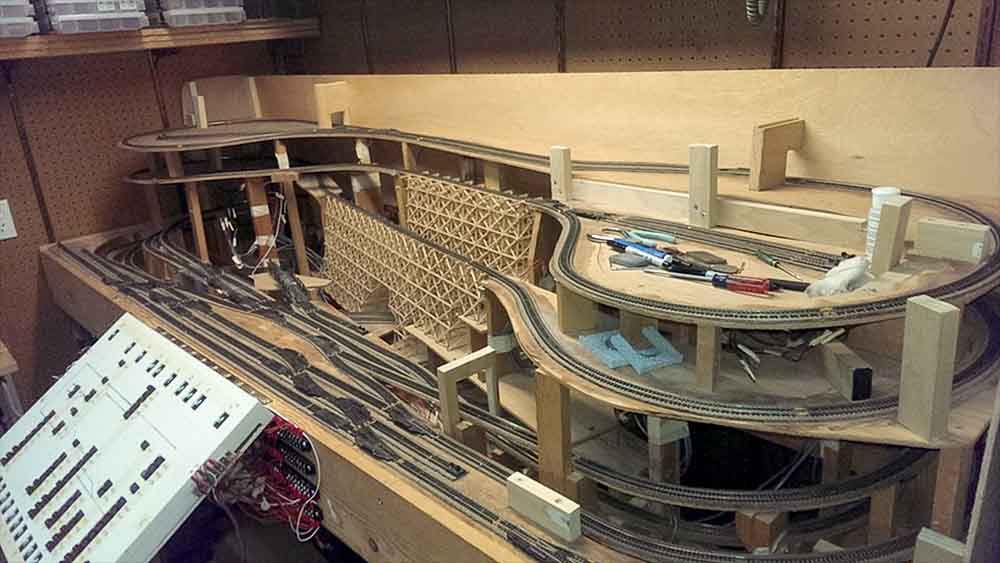
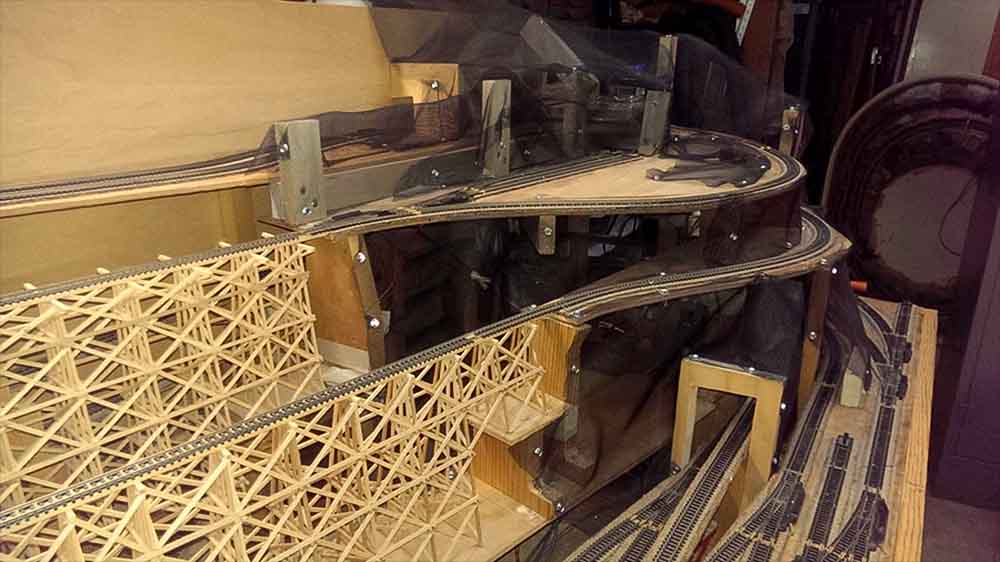

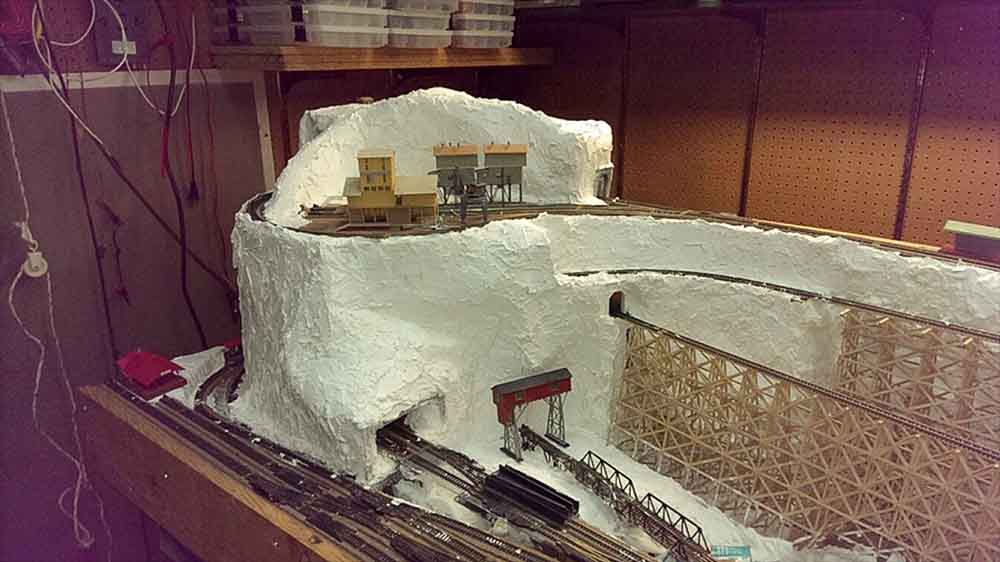
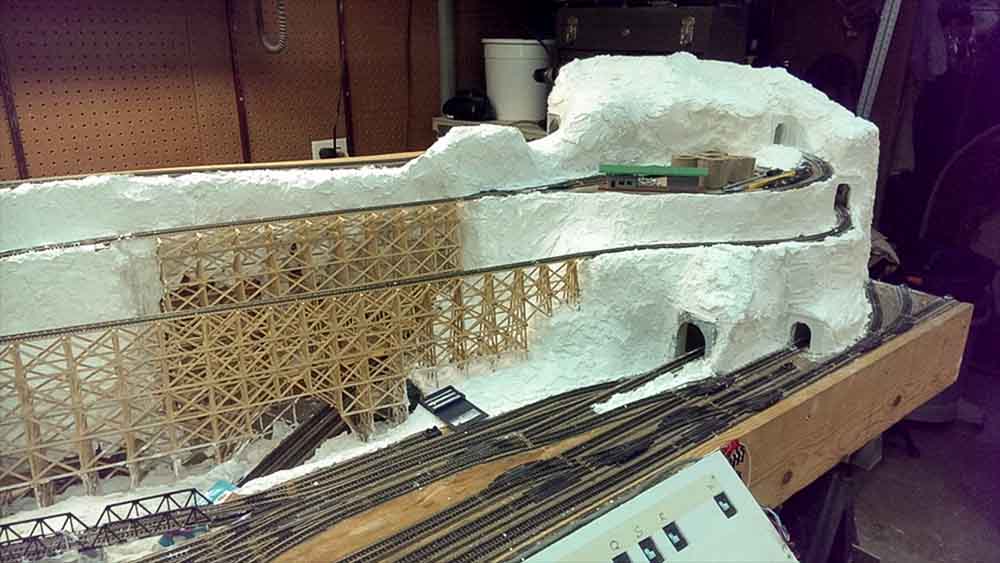
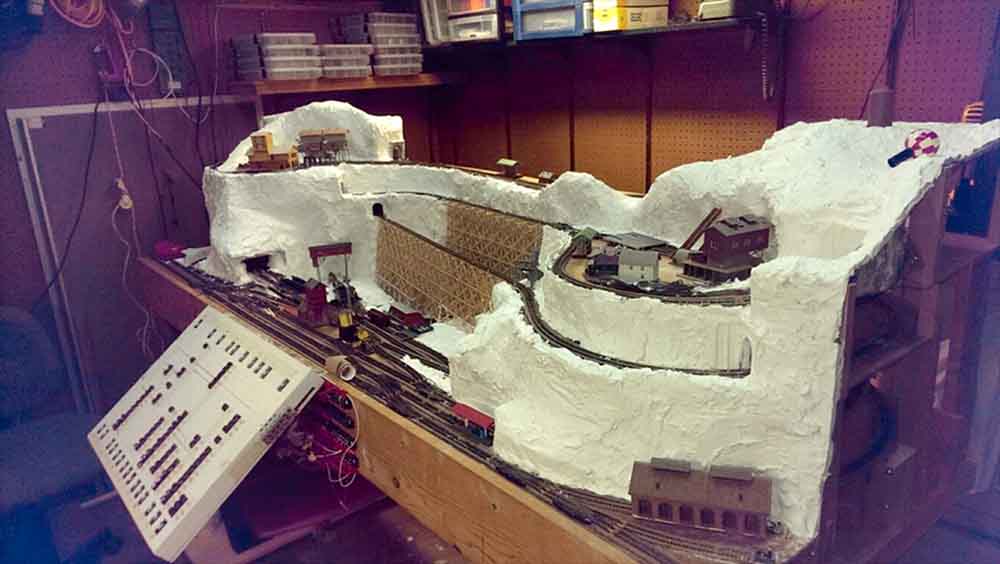
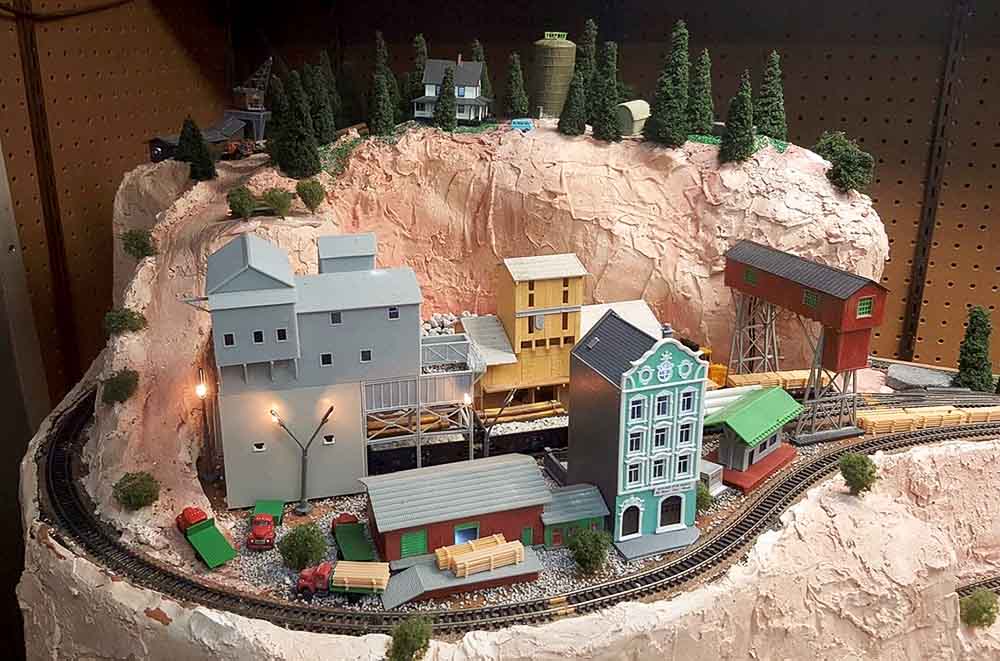

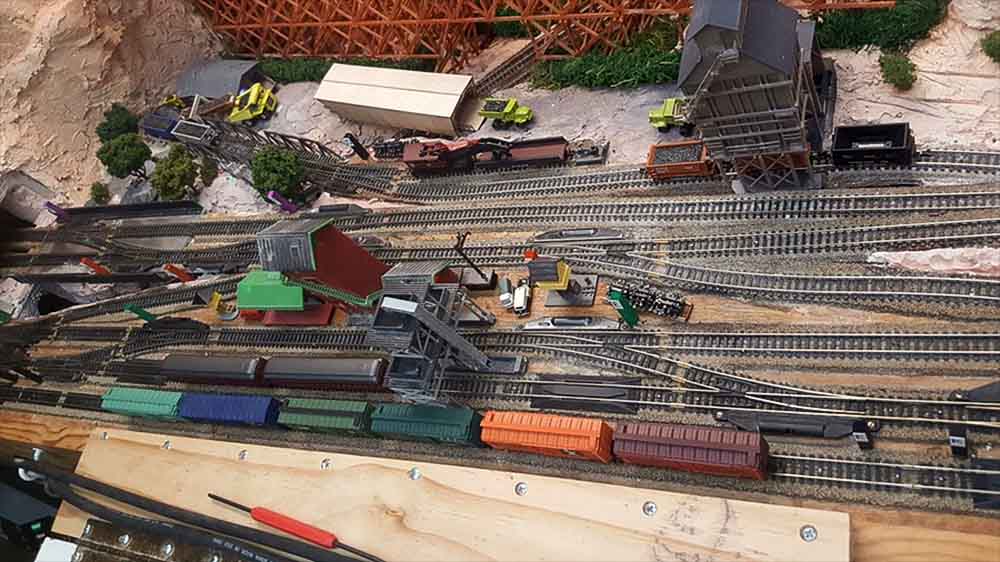
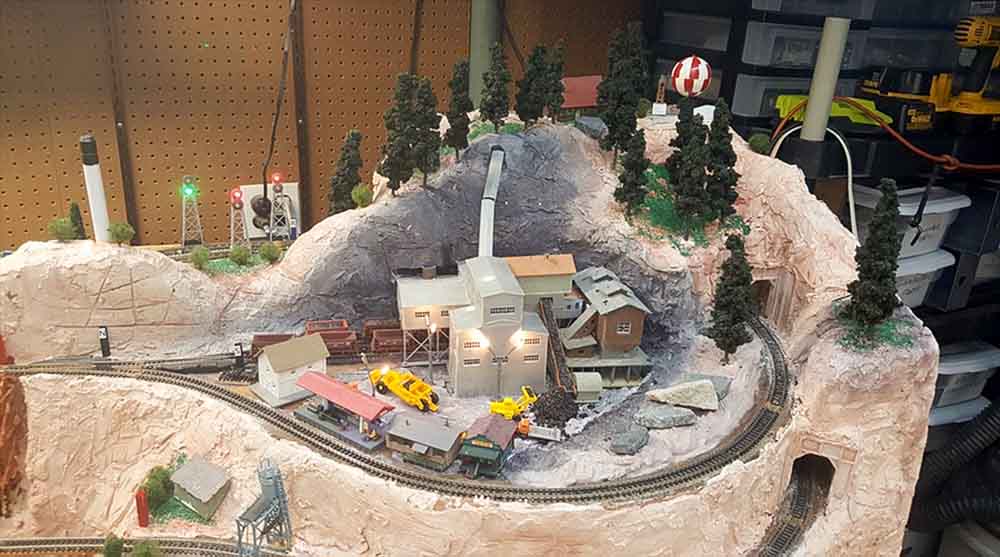
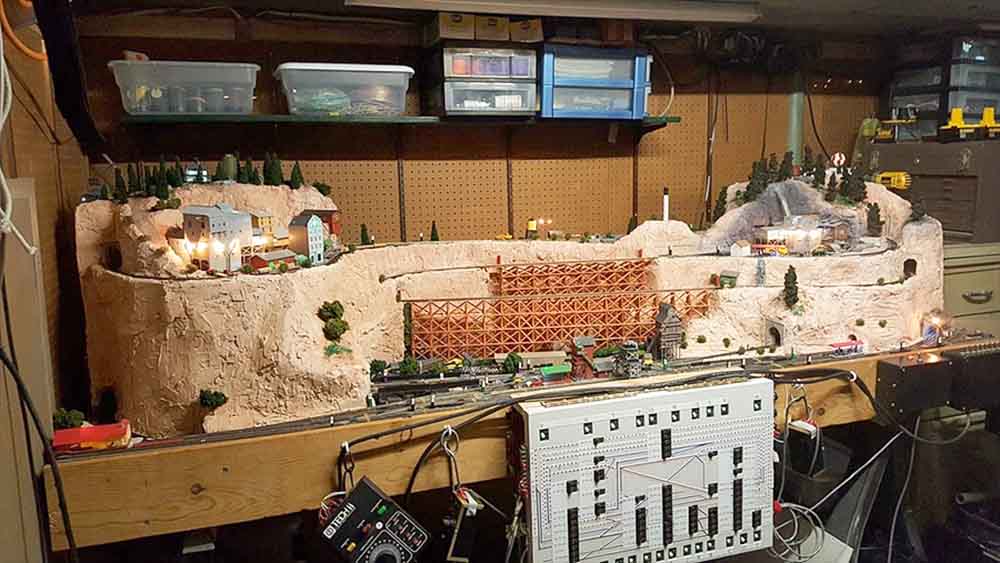

Some wonderful track work and modelling Richard
Andrew in Oz
Great looking and a good design. The twin trestles are particular outstanding and quite believable in their location. I’m not sure about the hotels and stores at each work site. Would these workers not go home at night, if not I think it work be more like bunk houses rather than a hotel. More description and photos of the lower area would be good if you send them in. One comment, and I suppose it is due to space considerations is the steepness of the mountain sides more like towering cliffs. In reality I doubt if there would be any construction close to the bases of the cliffs due to the treat of rock falls. Again a nice layout. Well done
Great bridge / trestle work I agree with Colin with the hotel location. Have you considered derailment problems behind the scenes ? All aside great landscape / scenery.
The Critic
Richard has clearly embraced a lifelong pursuit of the hobby, and has demonstrated a good deal of professionalism in his modeling skills. Track beds, grades, wiring, electrical all seem exemplary, and the trestles are masterpieces.
I do agree with Colin Edinburgh’s comment regarding the scenery though … excessive verticality due to limited space availability, which gives the overall layout a fantasy-like, ‘wedding cake’ appearance, which detracts from realism.
Look great.!!!!!!
Awesome ! ! !
Great Planning on the Many Levels of RR Track on the layout.. AND the Control Panel with the Wiring very well planned out and built. The Trestles are Great as are the different scenes. If You expanded, you could have a large town and a smaller one to serve the industries and their employees as well as using a terminal yard to exchange cars with foreign railroads to get the products to market. The Mining and Timber industry locations, could have just Temp Housing Work Camps common to their practice at the time. Put the ornate hotel in a large town across from a main RR Station to serve travelers of the line and the adjoining main line trains coming thru. You could have a Company Store at the mine and one at the Timber locations with small one story homes, shacks, sheds and tool buildings that were common practice. Adding More Trees and Shrubs to the Mountain and Hill Sides would Not make them as barron looking. You could put a small turntable with an engine facility to service the locomotives..or a Two Stall Engine House. Yard master office, sheds, block control tower. IF you had the around the wall space level with the upper part of the layout, you could put in a narrow shelf extension to go around the room to give longer train runs. Though I have HO Scale Trains, your layout is inspirational for anyone modeling in any scale with good planning tips as well. ~ Mike in Lebanon, N.H. USA.
Nice layout, do you still have your American Flyer trains? I have and run AF trains, and I’m always interested in finding more. Hi-rail trains like Flyer and Lionel are not as realistic, but are very collectible and a lot of fun.
Love your layout with all the trestles. Excellent planning.
Looking great….I like the trestles and awesome scenery. Sorry to say my RR train layouts are a thing of the past. no space in small apartment, but I immensely enjoying seeing what others are doing. A great enjoyment for me to see what others are doing. Keep up the good work.
Looks great!! Pay no attention to the critics. It’s your layaou, do it your way. That’s all that matters.
With regard to onboard battery backup, I seem to recall reading about the use of a special system involving capacitors and a controller circuit bult into a chip designed especially for such a system.
If any reader has experience with such a system or knows more about the concept, it might be helpful for all of us to know more about!
Love the trestles. You have packed a lot of action into a small space. I know you are limited in space, but my only comment is too much hidden track that leads to unseen problems like derailments and dirty track. I hope my layout turns out as good as yours.
Wow! Your trestles would give a lift to any layout.
Many regards,
Joseph, in Milwaukee.
Did you make the mine buildings or are they available in kit form? Who might the manufacturer be? I’m building a similar layout right now and I see a lot of great ideas in your layout. Thanks for posting all the pictures and I’m looking forward to seeing your addition. Very nice work but a thirty year break in construction? WOW!
WOW! What a nice piece of work (especially the trestles). Enjoy your efforts in good health.
Lots of good work! Your very tall scenery creates a perfect chance to do some cut-away views of what’s going on INSIDE the mines!
And just when you’ve thought you have seen it all. A entire graduated RR and built like a tank to top off. And I would not change a thing, even the surface mt. switches are quite acceptable! Again the coal mine is only 2ndary to the trestles for landmarks.
The footprint is perfect with more than enough to do with allotted space horizontal and vert. Speaking of power losses, a few well placed DC capacitors? Probably just low voltage, may distort DCC duplex signals? Track grime… can’t say there.
Speaking of capacitors, finished up with my Power Factor Capacitance project. Findings were mind boggling, calls for different config. of circuits. Not for this forum anyways.
Just noted James’ idea on inside mines, absolutely…
Rich. 😵💫
Oh no……..the workers have to reside in a pretend hotel next to a pretend railroad. Nice job. You had a building you wanted to use……….called it a hotel.
Now you have been critiqued that the workers should go home to their pretend houses rather than stay at the pretend hotel
Always admire those with the skill (and patience) to build elaborate trestle bridges. Well done.
You can see the thought process has resulted in a superb layout using minimal space. Excellent job!
It’s almost as amusing reading how ridiculous the critics are as reading about your story and seeing the construction come alive. I can’t wait to hear what the critics say about my layout once they see a crashed alien spaceship up in the hills. I wonder if the alien will check into my motel or fly back to Drago~Zorb where they came from. We have to be realistic right? Great job on your planning and execution. Have fun my friend!
Love your mini-world! I wouldn’t pay any attention to the detractors mate. You’ve got a work of art there. Unbelievably intricate and impressive. I envision a time when you operate your trains with cameras and battery operated engines so you don’t walk with the trains or hover over them…you actually run them from the cab controls. Well done! Very well done!
nicely done
Richard
Awesome planning and craftsmanship. I think the operation is a gas. Your trestles are fantastic and your fabulous layout is beyond interesting.
Your narrative defined what is what and I’m confused why anyone would make a comment to change it. Its your plan & a great one it is.
I guess you’re committed to the battery concept ( BC) which is a monumental step in this hobby and especially for N scale. BC removes all the DCC interrupts at turnouts, allows passing over a poor conductive joint and dirty track, and todays technology allows new thinking. All the block and reverse loop wiring goes away and the only concern left is proper switching. A BC con is that the engine keeps running after a derail which can reek havoc on a layout.
So please keep us informed -good or bad- so we fans can learn something as we did by studying your creativity.
Big Al
Wow! Great missive. You know how to reel in the fish! 😊
Danka
love the trestle work. grest layout.
Consider the ESP32 for control purposes. Cheap and small, it has both a Bluetooth and WiFi radios built in. Easily programmed with the Arduino IDE.
crazily complex. an architectural nightmare, I can’t imagine cleaning the antique track for operation. impressive build
Way to go Ken! Can’t wait for the spaceship crash. Maybe I should post my Dino Train, the kids enjoy it….I could make the critics fall off their high perch..
Al,
I do appreciate the comments provided on my long term project especially the trestles. In preparation for a down sizing, I have begun to take down the N gauge coal and lumber railroad using a chain saw. I am planning on changing to HO in the next iteration of my empire, because I have not been able to locate Shay type engines in N gauge. I am aware of the doubling of the size but I really want to create a shelf model railroad of Shay Engines. I have been designing the Shay shelf system using MS Visio and will send in progress reports as they become available.
I have a boxed set roughly 70 years old I will be selling…extremely reasonable. Please let me know if you are interested. BTW…I very much enjoyed seeing your layout.
What a great layout! could you please send us a video of it in operation. Thank you so much for sharing. Cheers Rossco, Adelaide, South Australia
Seems like controlled Chaos to me.
Very impressive work , must have taken quite a bit of figuring to make all that work . I like it it , great imagination and determination. Would like to see a video of the trains going round when you’ve reached that point please do post. Thank you .
Wow!!!! That’s an amazing job on your layout!!! The bridge turned out awesome a lot of hard work with that but a hell of a great ! Thank you for sharing your ideas and pics definitely motivating. Chris – Michigan
Great illustrations and narrative.
Richard, I commend your 55-year effort to build your model railroad and to do it in N-scale at that! I’m very impressed with the way you were able to support your extended helix tracks on the back side of the layout. I had a similar design for the Christmas layout I started in 1997 and had to remove one level of the layout because I couldn’t figure out how to support 3 tracks on top of each other.
My only criticism of your layout is that the emphasis on verticality and the extended helix concept leaves very little free space for the logging and mining focal points. They look rather crowded with too many structures in two small spaces. I think the hotel at the logging camp looks out of place and would be better placed on your lower-level town area. A few worker shanties or even bunk car for the workers would use less space.
All in all, I think you’ve done a great job of sticking with a plan and implementing it over a long construction period while adapting to changing conditions and technology. I wish you the best of luck with your conversion to battery-powered N-scale locomotives.